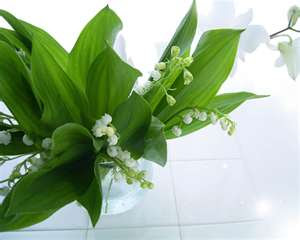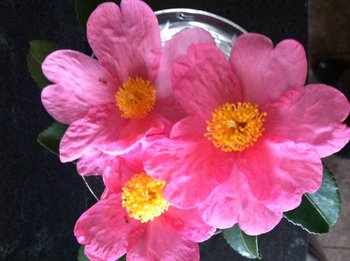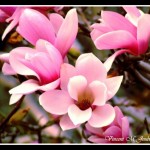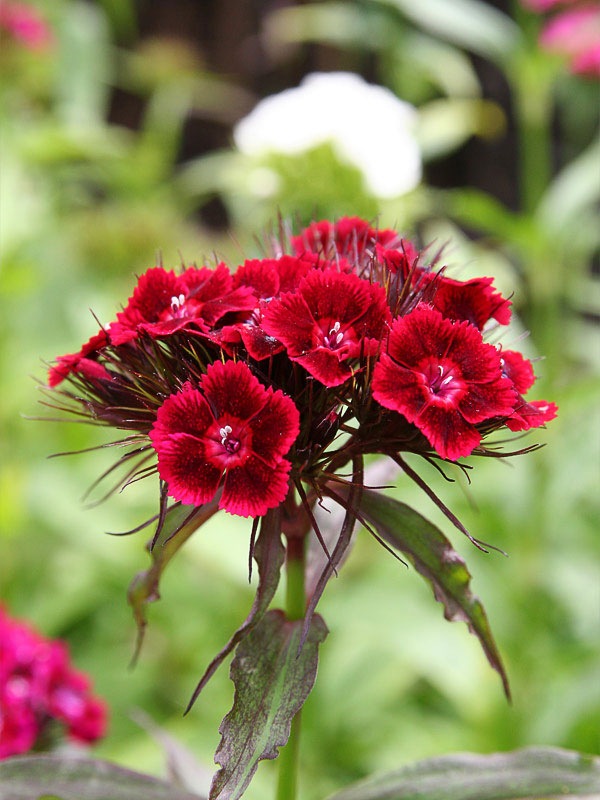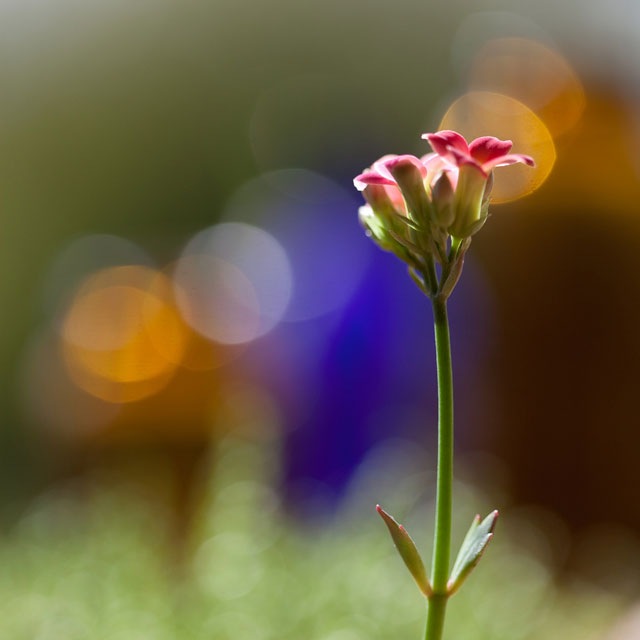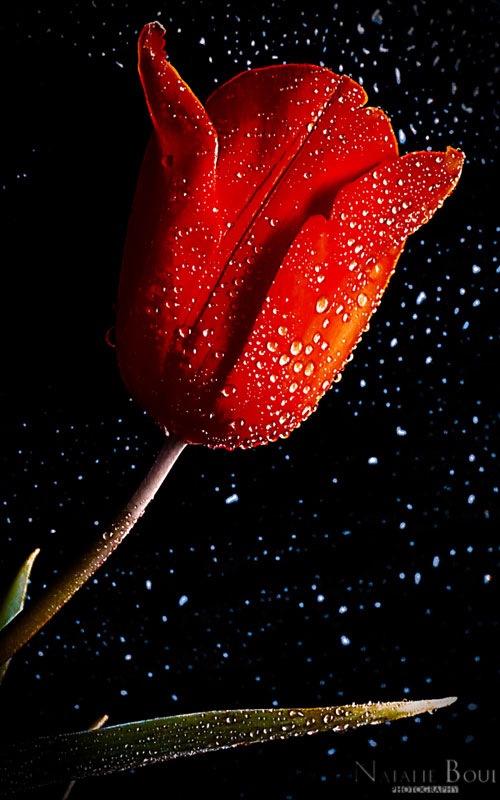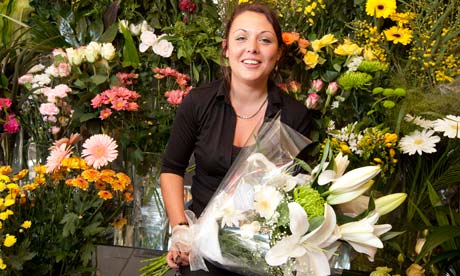
Storm Emin at work in her florist shop in St Albans. Photograph: Frank Baron
The man on the end of the phone has an audibly guilty conscience. His tone is sheepish and he doesn't know a dandelion from a day lily. One thing is clear: he needs mollifying flowers sent at the double to his spouse.
"We can always tell when a man's in trouble," says Jean Dennis, owner of Bloom florists in St Albans, Hertfordshire. "The trick is to find out how much trouble he's in and then work out how to get him out of it."
Gerberas might be his salvation, a single rose, or an artful spray of lisianthus, depending on the nature of his sin and the preferences of the wronged partner. The future of the relationship is then in the hands of Storm Emin, who creates the striking floral confections which distinguish Bloom from common-or-garden florists. She and Dennis will even help the anxious sinner phrase a suitable message and send him a text when the bouquet has dispatched, hoping that it all works out.
Most of life's dramas are brought to Bloom's unassuming door. Their bouquets hail babies and baptisms, they ornament brides, congratulate graduates, comfort the sick and honour the dead. And, of course, apply first aid to ruptured romance. There's a story behind every new order and a grasp of rudimentary psychology is a skill as vital to modern floristry as green fingers, since flowers alone will make nobody's fortune when they are so cheaply and readily flogged by supermarkets.
"In a recession, flowers are the first things to go," says 27-year-old Emin, although she has noticed a resurgence of people buying flowers to take to a dinner party. Those wanting to make a fragrant gesture can grab an acetate cone of carnations from a petrol station for half the price of one of Bloom's bunches, but it can be a false economy. A single stem, gracefully beribboned and co-ordinated with a hostess's upholstery, will speak far more eloquently and it is likely to outlive its supermarket relations by several days.
"People go by the look of flowers without thinking about the quality," says Emin, who has spent the morning trimming sheaves of eucalyptus stems. "Our flowers are cut fresh from the nursery and come straight here to be conditioned and refrigerated, whereas supermarket flowers languish for up to two days in a warehouse and then are dumped in buckets on the shop stands without proper preparation."
The unofficial counselling services are, however, the ingredient that sets good florists apart from superstores and it's this that has helped Bloom to flourish while many florists have gone to the wall. It was a failing business when Dennis took it over in 2009; now sales are up 70% on last year thanks to the personal service, a blitz on networking sites and a 7pm closing time which caters for panicked commuters who have remembered the wife's birthday on the train.
It helps, too, that the shop has diversified, offering picture framing and greetings cards. "The cards draw people in affordably," Dennis says. "They come to the till to pay for a card and then pluck up the courage to ask the price of a lily, whereas people can be nervous about entering a traditional florist because they're unsure what they want or how much it will end up costing."
While Emin is scissoring her eucalyptus in the back room, an elderly lady sidles up to the till. She eyes up the stands of exotica and looks nervous. Dennis strides over, exuding kindly authority. The customer needs flowers for a relative's funeral, but doesn't know where to start. Dennis steers her from thoughts of a wreath to a basket of flowers that can more suitably be donated to a hospital after the funeral and she agrees to write out the attached message since the customer mistrusts her own handwriting. "A big part of the job is a listening ear," she says. "You can always tell a funeral party when it comes in and you have to put them at their ease, hear out their story and encourage them to think things through."
Emin, having trimmed and tidied that morning's delivery, is now darting about the shop floor plucking blooms from stands and crafting them into pre-ordered bouquets that Dennis and her brother then deliver at any time, on any day. "I like open orders most because I know which flowers are at their best at the moment and which will best suit the environment they're wanted for, but some people have set ideas which can be a challenge," says Emin.
"When I first started in floristry a bride wanted sprays of purple, red and yellow with white gypsophila. She obviously didn't know what she was talking about, but she insisted we go ahead and when she came and saw the results just before the wedding, she burst into tears. Since then I always warn people if I think their ideas won't work."
Brides are both the lifeblood and the torment of florist. "A lot of people think that you make big money from weddings, but that's not true," Emin says. "Consultations take an hour or two and we don't charge for them and the conditioning and arranging of the flowers can take a whole day. One day this summer I was organising flowers for a wedding for 12 hours – 1,080 carnations and 200 lisianthus had to be conditioned, divided and arranged and I had a massive blister on my hand from the scissors."
There are pedantic brides who want to organise the minutiae of their bouquet 18 months in advance – "climate change is making it very difficult to predict what will be available when," Dennis says, "this spring £1m wouldn't have bought you lily of the valley because it finished flowering a month early" – and last-minute brides who come in a fortnight before the big day and want Hollywood extravagance on a shoestring. One rang in on the morning of her nuptials after another florist had let her down and Emin had to construct her bouquet on the spot.
Then there are brides who think that vulgar money-talk will sully the romance. "People are strangely reluctant to tell you their budget so we have to work blind," Emin says. "Then they always throw something at you at the last minute. At one wedding the bride's mother-in-law suddenly insisted I stick wired flowers all over the cake. I'd no idea if she'd consulted the bride."
The long, cold, poorly paid hours of floristry were never part of Emin's life plan. Fashion design was her ambition until a canny careers adviser warned her against the long training required. "She suggested floristry instead, which I thought was the biggest joke ever because I was a tomboy, but I changed my mind after working in a flower factory in Skegness," she says. "I realised I loved flowers."
She completed an advanced national certificate in floristry and has since worked her way round eight florists, including her own shop which she disastrously set up just before the credit crunch. "There's not a lot of money in floristry," she says. "And because of that a lot of people cut corners and take advantage of you. One boss didn't pay my national insurance and another kept my savings for me in his safe then wouldn't give them back to me when I left. You either do something for the money or because you love it and in floristry, it has to be love because even in London £15,000 is a good wage."
The day starts at 8am when Emin and Dennis check overnight internet orders and those from other florists. Flowers are delivered from nurseries three times a week and have to be conditioned, watered and arranged on the stands or stored in the large refrigerator. Then the phone starts ringing, passers-by wander in and bouquets have to be assembled for delivery.
Predicting daily demands is a feat that, if not accomplished precisely, can bring down a business – the stock is a perishable investment. Valentine's Day, which – along with Mother's Day – is the busiest day of the year, is usually a predictable affair involving a single flower, but this year, Emin says, customers branched out and red-hued exotica was in demand. She and Dennis endeavour to forecast demand by keeping abreast of style trends – lilies are currently the most popular flower – but the most important skill is subtly to modify customers' ambitions to suit what's on the stands.
"People who phone in can't see the display, so it's up to us to nudge them and often people who come in don't know what they want, so we can steer them towards what we have that will be appropriate," says Emin.
This they do so successfully that Bloom only bins around £5 worth of stock a day and customers, having had their emotional lives expertly soothed by a flower, often become reliant on Emin and Dennis's counsel to steer them through life's landmarks.
"Money's immaterial, it's what will convey the right message for the occasion that matters," says Emin. "One man wanted to propose to his girlfriend and didn't know how. We suggested a single red rose with a diamanté pin through the leaf. He now rings us up before every birthday and anniversary and asks us to be his personal adviser."
Much of the shop's business is to those amnesiac commuters on the way home from the station. Bloom will text them reminders of important occasions if they request it and leave bouquets out of hours at the neighbouring wine shop to spare them wifely wrath. "To survive when most florists have closed shop, you have to be ready for anything," says Emin. "You can say what you like under your breath so long as you do it with a smile."













